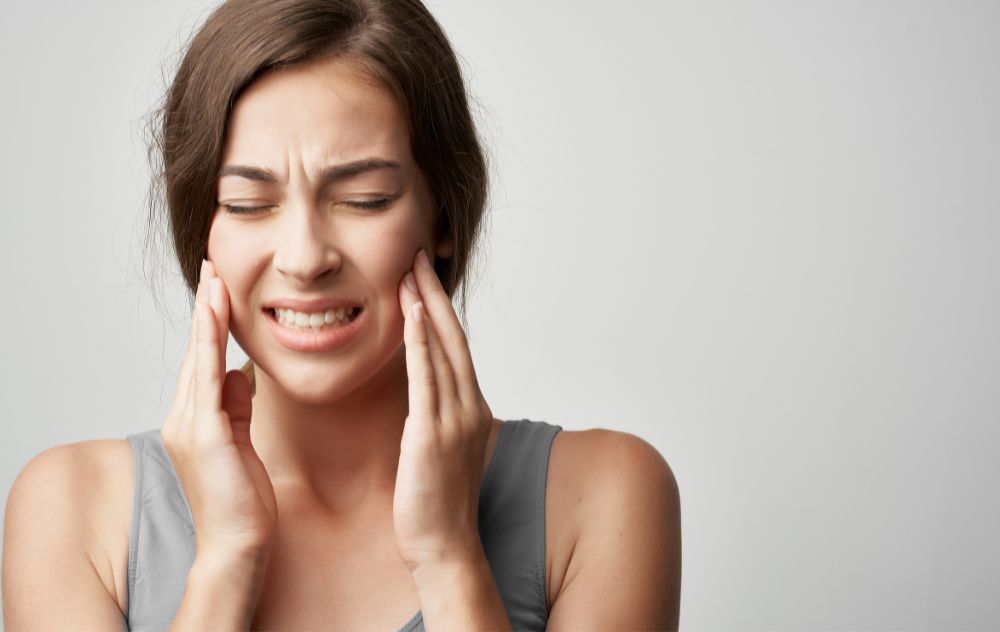What Is Orofacial Pain?
Orofacial pain refers to discomfort that affects the jaw, face, head, or related structures. This type of pain often involves the temporomandibular joint (TMJ), which connects the jaw to the skull, but other muscles and nerves in the head and neck can also contribute.
- Pain may feel localized in the jaw but spread into the face, head, or ears
- TMJ disorders are a common source, but headaches, clenching, and sleep-related issues may overlap
- Symptoms often appear in more than one area, which can make the cause difficult to identify

Common Symptoms You Shouldn’t Ignore
Because the muscles and nerves of the face, head, and neck are so interconnected, pain can show up in unexpected ways. Recognizing patterns can help you decide when it’s time to seek care.
- Jaw stiffness, locking, or clicking and popping noises when opening or closing the mouth
- Headaches or migraines that intensify after chewing, yawning, or stressful days
- Ear-related symptoms such as ringing, pain, or pressure without signs of infection
- Neck and shoulder discomfort that worsens with jaw use
- Dizziness, vertigo, or feelings of imbalance
Why Choose TMJ Therapy & Sleep Center of Colorado
Dr. Kevin Berry focuses his practice on helping patients resolve jaw and sleep-related conditions without surgery. His advanced training in orofacial pain and oral medicine guides a treatment philosophy centered on correcting causes rather than masking symptoms.
Patients choose this Denver practice because:
- Care is conservative, comfortable, and non-invasive whenever possible
- Diagnostic testing and treatment planning happen in one convenient location
- Personalized treatment plans are built around your lifestyle and goals
How We Diagnose Orofacial Pain
Accurate diagnosis is the first step toward long-term relief. Our team begins with a thorough conversation about your symptoms, health history, and daily habits before moving into a physical exam.
- Examination of jaw movement, bite alignment, and muscle tenderness
- Bite analysis in both relaxed and functional positions
- Screening for related conditions such as teeth grinding, sleep apnea, or posture-related tension
Technology We Use to Pinpoint the Cause
Modern diagnostic technology allows us to look beyond surface symptoms and find the true source of pain.
- TENS (Transcutaneous Electrical Nerve Stimulation): A comfortable, non-invasive method to relax jaw muscles, so accurate measurements can be taken
- iCat® CBCT Imaging: A 3-D scan of your jaw joints and facial structures that provides more detail than traditional X-rays with lower radiation exposure
- Digital Scanning and 3-D Printing: Medit intraoral scanner and Luxe Creo printer allow us to design and create custom orthotics in-house
- iTero Scanning: A digital tool used to make precise sleep appliances when airway-related conditions are involved
Treatment Options for Orofacial Pain
Most patients respond well to stepwise, reversible therapies. At TMJ Therapy & Sleep Center of Colorado, treatment plans are personalized, gentle, and designed for lasting relief.
- Education on habits, posture, and dietary changes that reduce strain on the jaw
- Periodic use of TENS therapy to relax tense muscles
- Custom neuromuscular orthotic devices to improve bite balance and relieve stress on joints and muscles
- BOTOX® therapy to ease persistent muscle-driven pain when appropriate
- Trigger point injections or prolotherapy to address local muscle knots or ligament tension
What a Neuromuscular Orthotic Does
An orthotic device, often similar to a bite splint, positions the jaw in a more stable and relaxed alignment.
- Helps reduce strain on inflamed joints and overworked muscles
- Typically worn full-time at first, then transitioned to nighttime use
- Can be adjusted as healing and comfort improve
When Injections Make Sense
Sometimes, orofacial pain stems from highly focused areas of tension. Injections can provide targeted relief.
- Trigger point injections release tight muscle fibers that generate radiating pain
- Prolotherapy stimulates the body’s natural healing in ligaments or tendons for long-term stability
Role of BOTOX® in Orofacial Pain
When jaw muscles remain overactive despite other treatments, BOTOX® may help.
- Temporarily relaxes overworked muscles to reduce clenching and associated pain
- Often improves tension-related headaches and facial discomfort
- Works best as part of a comprehensive treatment plan
Conditions Commonly Linked to Orofacial Pain
Because orofacial pain is multifaceted, it often overlaps with other conditions. Addressing these together helps create a clearer path to relief.
- TMJ Disorder (TMD): Bite imbalance, joint inflammation, and chronic muscle strain
- Headaches and Migraines: Pain along the trigeminal nerve may be triggered by jaw tension
- Ear Symptoms: Tinnitus, dizziness, or a feeling of fullness caused by shared anatomy between the ears and jaw joints
- Sleep Concerns: Conditions such as snoring or sleep apnea often relate to jaw positioning and may worsen morning headaches
Your Visit: What to Expect
Your first appointment is designed to answer questions, confirm the source of your pain, and create a plan.
- Detailed consultation about your symptoms and health history
- Physical exam and digital records taken during the same visit when appropriate
- Easy-to-follow home instructions and scheduled check-ins to monitor progress
Phase-Based Care, Explained
Treatment often follows two phases.
- Phase I: Relief-focused therapy with reversible methods like orthotics, TENS, and lifestyle coaching
- Phase II: When necessary, longer-term orthodontic or restorative solutions to maintain improvements
Frequently Asked Questions
Ready for Relief in Denver?
If jaw or facial pain is making daily life difficult, you don’t have to live with it. At TMJ Therapy & Sleep Center of Colorado, Dr. Kevin Berry and his team provide compassionate, non-surgical care to help you find lasting comfort.
Call us today at (303) 691-0267 or use our online booking form to schedule your consultation online and start your path toward relief.
